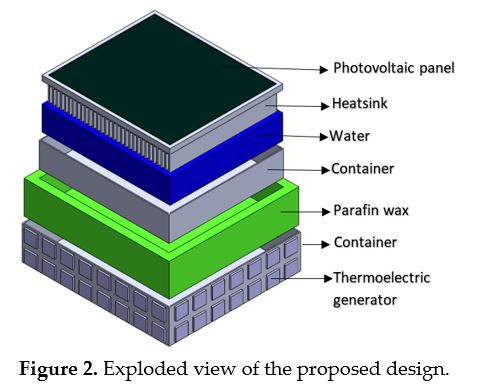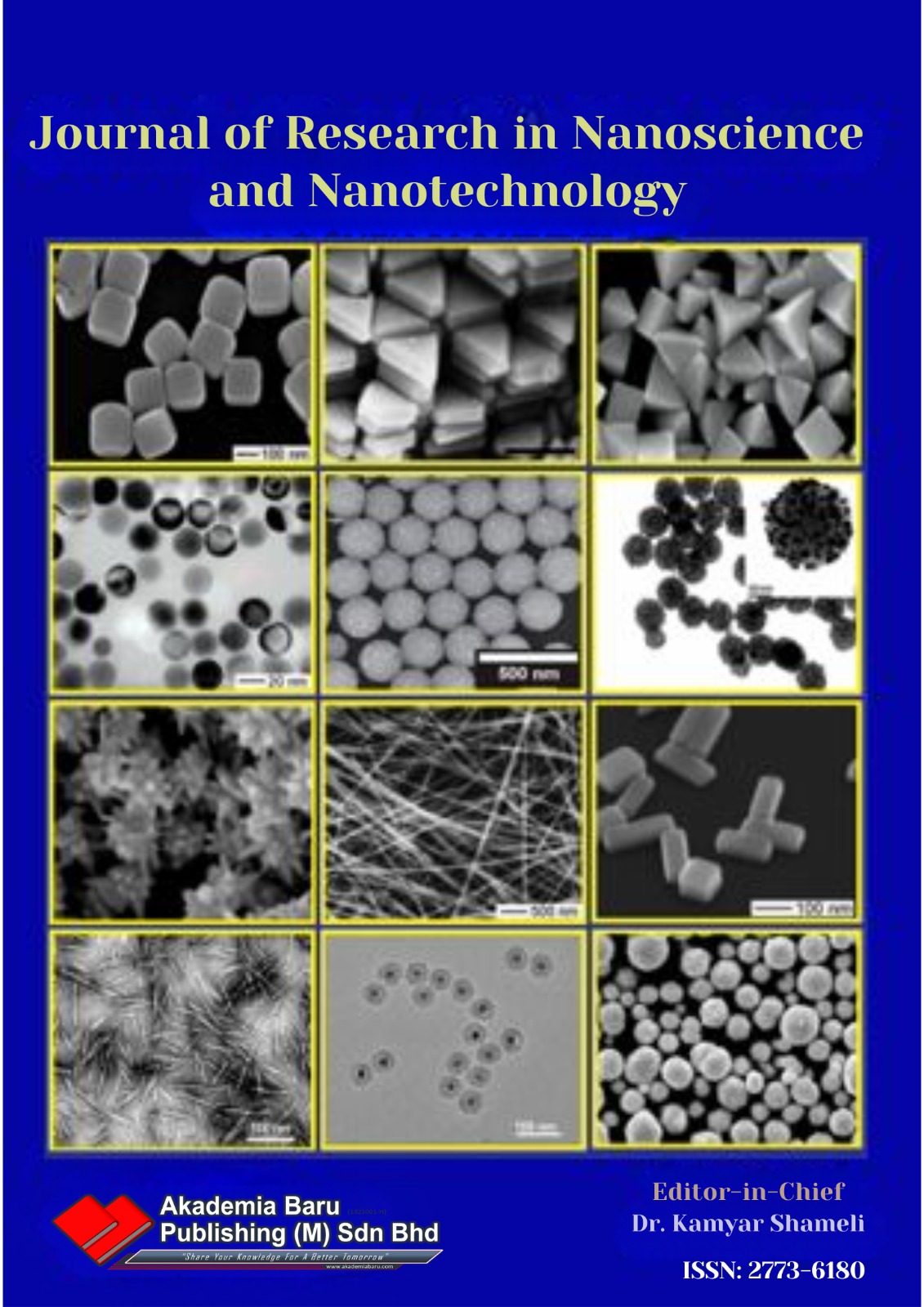Performance Analysis of Photovoltaic Passive Heat Storage System with Microencapsulated Paraffin Wax for Thermoelectric Generation
DOI:
https://doi.org/10.37934/jrnn.1.1.7590Keywords:
Renewable energy, PVT system, TEG, CFD simulation, Transient thermal analysis, Microencapsulated paraffin waxAbstract
The depletion of non-renewable energy sources and negative effects towards the environment push research towards the widespread adoption of renewable energy sources such as solar energy. The main drawback of solar panels is that temperatures above 27°C will result in an efficiency drop of 0.1-0.5%/°C. In previous studies, usage of photovoltaic thermal (PVT) systems was mainly for the purpose of heating water, warming buildings, and drying crops. This research will focus on the usage of a standalone PVT and thermoelectric generator (TEG) system whereby it uses heat extracted from the PVT system for thermoelectric generation. A passive standalone PVT-TEG system design with microencapsulated paraffin wax as a phase change material (PCM) as a heat storage medium was created. The heat stored in the PCM is used as a heat source for thermoelectric generation. To extract the heat from the PV panel, an aluminum heatsink underneath the PV panel is used as a heat absorber to passively extract heat without external power sources. This setup reduces the surface temperature by 22.7°C. Transient thermal analysis and thermoelectric simulation of the system was conducted through Computational Fluid Dynamics (CFD) using ANSYS 2019 software. The error recorded between the experimental and simulation results was 4.2%. This proposed system panel successfully increased the electrical efficiency of the PV panel by approximately 12.8%, where the overall electrical power produced shows a significant increase from 7.7W to 17.7W.
Downloads
References
P. Moraitis, R. E. I. Schropp, and W. G. J. H. M. van Sark, “Nanoparticles for Luminescent Solar Concentrators - A review,” Opt. Mater. (Amst)., vol. 84, pp. 636–645, 2018, doi: https://doi.org/10.1016/j.optmat.2018.07.034.
Y. Andrea, T. Pogrebnaya, and B. Kichonge, “Effect of Industrial Dust Deposition on Photovoltaic Module Performance: Experimental Measurements in the Tropical Region,” Int. J. Photoenergy, vol. 2019, p. 1892148, 2019, doi: 10.1155/2019/1892148.
Y. Tian and C. Y. Zhao, “A review of solar collectors and thermal energy storage in solar thermal applications,” Appl. Energy, vol. 104, pp. 538–553, 2013, doi: 10.1016/j.apenergy.2012.11.051.
A. Ibrahim, M. Y. Othman, M. H. Ruslan, S. Mat, and K. Sopian, “Recent advances in flat plate photovoltaic/thermal (PV/T) solar collectors,” Renew. Sustain. Energy Rev., vol. 15, no. 1, pp. 352–365, 2011, doi: 10.1016/j.rser.2010.09.024.
C. Lamnatou and D. Chemisana, “Photovoltaic/thermal (PVT) systems: A review with emphasis on environmental issues,” Renew. Energy, vol. 105, pp. 270–287, 2017, doi: 10.1016/j.renene.2016.12.009.
A. G. Lupu, V. M. Homutescu, D. T. Balanescu, and A. Popescu, “A review of solar photovoltaic systems cooling technologies,” IOP Conf. Ser. Mater. Sci. Eng., vol. 444, no. 8, 2018, doi: 10.1088/1757-899X/444/8/082016.
S. Shittu, G. Li, Q. Xuan, X. Zhao, X. Ma, and Y. Cui, “Electrical and mechanical analysis of a segmented solar thermoelectric generator under non-uniform heat flux,” Energy, vol. 199, p. 117433, 2020, doi: 10.1016/j.energy.2020.117433.
Y.-Y. Wu, S.-Y. Wu, and L. Xiao, “Performance analysis of photovoltaic–thermoelectric hybrid system with and without glass cover,” Energy Convers. Manag., vol. 93, pp. 151–159, 2015, doi: https://doi.org/10.1016/j.enconman.2015.01.013.
B. K?lk??, “Development of a composite PVT panel with PCM embodiment, TEG modules, flat-plate solar collector, and thermally pulsing heat pipes,” Sol. Energy, vol. 200, no. October, pp. 89–107, 2020, doi: 10.1016/j.solener.2019.10.075.
F. Rajaee, M. A. V. Rad, A. Kasaeian, O. Mahian, and W. M. Yan, “Experimental analysis of a photovoltaic/thermoelectric generator using cobalt oxide nanofluid and phase change material heat sink,” Energy Convers. Manag., vol. 212, no. February, p. 112780, 2020, doi: 10.1016/j.enconman.2020.112780.
A. Kolahan, S. R. Maadi, A. Kazemian, C. Schenone, and T. Ma, “Semi-3D transient simulation of a nanofluid-base photovoltaic thermal system integrated with a thermoelectric generator,” Energy Convers. Manag., vol. 220, no. May, p. 113073, 2020, doi: 10.1016/j.enconman.2020.113073.
S. Soltani, A. Kasaeian, A. Lavajoo, R. Loni, G. Najafi, and O. Mahian, “Exergetic and enviromental assessment of a photovoltaic thermal-thermoelectric system using nanofluids: Indoor experimental tests,” Energy Convers. Manag., vol. 218, no. April, 2020, doi: 10.1016/j.enconman.2020.112907.
J. Zhang, H. Zhai, Z. Wu, Y. Wang, H. Xie, and M. Zhang, “Enhanced performance of photovoltaic–thermoelectric coupling devices with thermal interface materials,” Energy Reports, vol. 6, pp. 116–122, 2020, doi: 10.1016/j.egyr.2019.12.001.
A. Makki, S. Omer, Y. Su, and H. Sabir, “Numerical investigation of heat pipe-based photovoltaic-thermoelectric generator (HP-PV/TEG) hybrid system,” Energy Convers. Manag., vol. 112, pp. 274–287, 2016, doi: 10.1016/j.enconman.2015.12.069.
R. Bjørk and K. K. Nielsen, “The performance of a combined solar photovoltaic (PV) and thermoelectric generator (TEG) system,” Sol. Energy, vol. 120, pp. 187–194, 2015, doi: 10.1016/j.solener.2015.07.035.
B. S. Dallan, J. Schumann, and F. J. Lesage, “Performance evaluation of a photoelectric-thermoelectric cogeneration hybrid system,” Sol. Energy, vol. 118, pp. 276–285, 2015, doi: 10.1016/j.solener.2015.05.034.
C. Babu and P. Ponnambalam, “The theoretical performance evaluation of hybrid PV-TEG system,” Energy Convers. Manag., vol. 173, pp. 450–460, 2018, doi: https://doi.org/10.1016/j.enconman.2018.07.104.
J. Darkwa, J. Calautit, D. Du, and G. Kokogianakis, “A numerical and experimental analysis of an integrated TEG-PCM power enhancement system for photovoltaic cells,” Appl. Energy, vol. 248, pp. 688–701, 2019, doi: https://doi.org/10.1016/j.apenergy.2019.04.147.
G. Li, S. Shittu, K. zhou, X. Zhao, and X. Ma, “Preliminary experiment on a novel photovoltaic-thermoelectric system in summer,” Energy, vol. 188, p. 116041, 2019, doi: 10.1016/j.energy.2019.116041.
J. Zhang and Y. Xuan, “An integrated design of the photovoltaic-thermoelectric hybrid system,” Sol. Energy, vol. 177, no. November 2018, pp. 293–298, 2019, doi: 10.1016/j.solener.2018.11.012.
A. A. Kadhem, N. I. A. Wahab, and A. N. Abdalla, “Wind energy generation assessment at specific sites in a Peninsula in Malaysia based on reliability indices,” Processes, vol. 7, no. 7, 2019, doi: 10.3390/pr7070399.
H. Li, L. Rong, C. Zong, and G. Zhang, “A numerical study on forced convective heat transfer of a chicken (model) in horizontal airflow,” Biosyst. Eng., vol. 150, pp. 151–159, 2016, doi: https://doi.org/10.1016/j.biosystemseng.2016.08.005.















